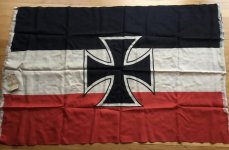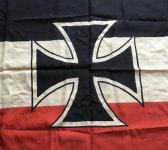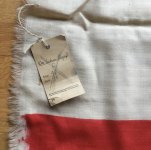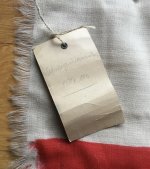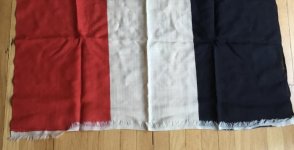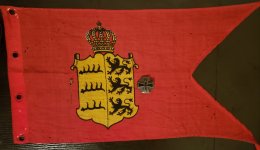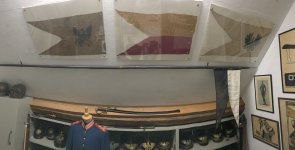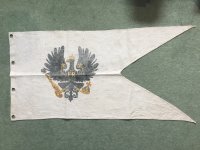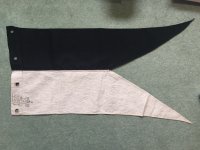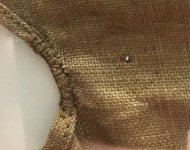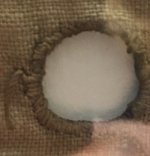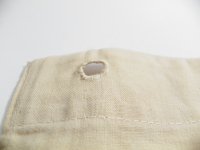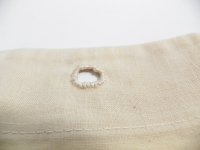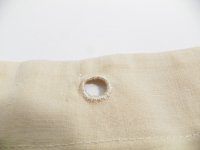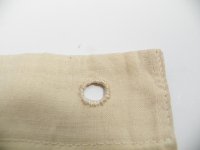ww1czechlegion
Well-known member
Hello,
I recently acquired a very nice large Imperial German Flag, along with 3-NCO Cavalry Lance Pennants from a good friend. He recently purchased them from the son of a WW2 veteran who supposedly brought them back to the U.S., along with several other 3rd Reich flags, and an unfinished Imperial Navy Kriegsschiffgosch Flag that was used from 1871 thru 1918, which I did not purchase.
The Pennants in question do not match the dimensions of the listed size in the book "The German Cavalry from 1871 to 1914" by Herr & Nguyen. And the swallow tail portion of each pennant does not have as long of "tails" as the examples shown in the book. They all seem to be a little longer than the listed length in the book.
Two of the pennants appear to be "unfinished" with them not having the 4-reinforced stitched grommet holes for attachment to the lance staff.
All 3-pennants appear to be nicely "silk-screened" printed, or whatever method they used to print the individual state design on each pennant. The color printing goes through the cloth to show on the reverse side of the pennant, although the color printing is somewhat weaker on the reverse side, especially on the Prussian pennant.
I feel foolish asking, but are these replicas, or what explanation is there for them being a bit longer in size, and two of them not having the 4-reinforced grommet holes, as if they were never completely finished?
The photos I will post were not shot directly above each pennant, therefore distorting the visual length of the top "tail" portion on each pennant, making it look shorter than the bottom "tail" of the swallow tail on each pennant.
Thanks,
Alan
Remember to "Click" on the Photos to Enlarge them!
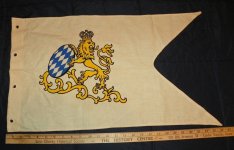
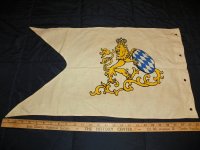
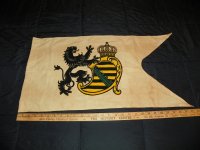
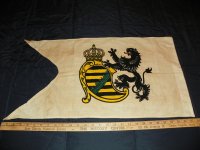
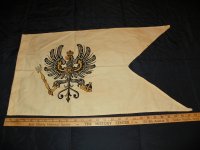
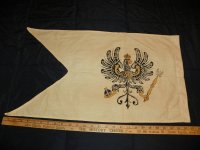
I recently acquired a very nice large Imperial German Flag, along with 3-NCO Cavalry Lance Pennants from a good friend. He recently purchased them from the son of a WW2 veteran who supposedly brought them back to the U.S., along with several other 3rd Reich flags, and an unfinished Imperial Navy Kriegsschiffgosch Flag that was used from 1871 thru 1918, which I did not purchase.
The Pennants in question do not match the dimensions of the listed size in the book "The German Cavalry from 1871 to 1914" by Herr & Nguyen. And the swallow tail portion of each pennant does not have as long of "tails" as the examples shown in the book. They all seem to be a little longer than the listed length in the book.
Two of the pennants appear to be "unfinished" with them not having the 4-reinforced stitched grommet holes for attachment to the lance staff.
All 3-pennants appear to be nicely "silk-screened" printed, or whatever method they used to print the individual state design on each pennant. The color printing goes through the cloth to show on the reverse side of the pennant, although the color printing is somewhat weaker on the reverse side, especially on the Prussian pennant.
I feel foolish asking, but are these replicas, or what explanation is there for them being a bit longer in size, and two of them not having the 4-reinforced grommet holes, as if they were never completely finished?
The photos I will post were not shot directly above each pennant, therefore distorting the visual length of the top "tail" portion on each pennant, making it look shorter than the bottom "tail" of the swallow tail on each pennant.
Thanks,
Alan
Remember to "Click" on the Photos to Enlarge them!






Last edited:

